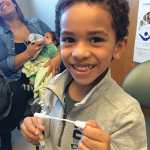In addition to the assistance that sites receive for setup and inclusion in the CARRA registry, the sites will also benefit from the fact that CARRAnet data will be federated, which means that sites will soon be able to access their own data without a gatekeeper, and compare them with data from other sites. Targets for the CARRAnet grant include the eventual participation of 60 sites with 20,000 subjects. The first CARRAnet site was activated in May 2010; 52 sites are currently active, and more than 3,000 subjects have been enrolled in the registry. According to Dr. Schanberg, there is an even split among CARRAnet centers that have extensive research experience, some research experience, and no previous experience, demonstrating that all types of centers can successfully participate in bringing research to more children with rheumatic diseases.
“It is incredibly gratifying to work with such a dedicated group of physicians,” Fox says. “They are truly passionate about what they’re doing, and that makes the whole team passionate about making CARRAnet work and building the structure we need to make a difference in the life of these kids.”
Building an Identity
The creation of CARRA helped pediatric rheumatologists in another way—by forging an identity for these physicians as a community pushing the field forward. The CARRA meetings—one held concurrently with the ACR Annual Scientific Meeting and a second, stand-alone meeting—have become forums for working groups that focus on pediatric diseases, like juvenile arthritis and pediatric lupus. “The disease-specific groups have developed into effective teams, and when the CARRAdx and CARRAnet grants came through, they were ready to go to work,” says Dr. Mellins.
“This year the CARRA meeting is in Miami,” says Dr. Schanberg. “We’re partnering with the PRSYM [Pediatric Rheumatology Symposium] meeting of the ACR. We expect more than 200 people, and this will be a working meeting,” she says. Among other projects, members will be developing consensus treatment protocols so that care of children with these diseases is standardized. “We also want to standardize the outcomes we look at, so that we can do comparative effectiveness research,” notes Dr. Schanberg.
A Guiding Light
Although they initially looked to several organizations as models, the founders of CARRA are unabashed in their admiration of one particular pediatric treatment network: the Children’s Oncology Group, which started as two groups that eventually merged. “They demonstrated a culture in which the standard of care is for each child with cancer to get placed on a protocol. A current treatment approach is tested against the best idea for a treatment that might be even better. As a consequence, in 20 years, the treatment approaches to childhood cancer have evolved and improved in a data-driven way,” says Dr. Mellins. She adds that recent decreases in childhood cancer mortality provide compelling evidence for this model of care.

As a community, we decided that every child with a rheumatic disease should have access to participation in a protocol, a registry, a clinical trial, or an observational study.
—Christy Sandborg, MD


